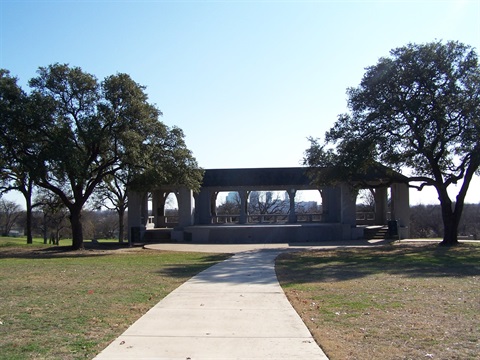Trail Drivers Park

Dedication
Size
Additional amenities
- Backstop
- Basketball court
- Bench
- Bike rack
- Bleachers
- Electrical box
- Observation deck
- Park lighting
- Parking lot
- Playground
- Restroom
- Shelter
- Softball/baseball field
- Stand-alone swing
- Table
- Trash receptacle
Fun facts
History
In 1928, the park board spent $13,000 for the acquisition of forty acres north of the Fort Worth Stockyards for a park to serve the Diamond Hill area. Located on Anderson’s Branch (named in honor of Abe Anderson who had a residence north of the park site), the parcel was once part of the trail system used to drive cattle from Mexico and South Texas to markets in the North. Fittingly, the park was named Trail Drivers Park. For bestowing it with such an appropriate name, G. W. Saunders of San Antonio, president of the Old Trail Drivers’ Association, sent a letter of appreciation to Park Superintendent George Clarke and sought to have a historical marker of some type acquired for the park.
Trail Drivers Park was seen as a critical link in Hare and Hare’s plan to connect the city’s major parks via the Trinity River Parkway as the park was located approximately halfway between Sylvania Park on the east side and Marine Park on the north. It was also known for its “swimming hole,” a favorite summertime spot for the children of area pioneers. Shortly after its acquisition, S. Herbert Hare was charged with developing a plan for it that included playgrounds and ball fields, and a band shelter. A drawing of this plan appeared in Hare and Hare’s 1930 park master plan but apparently few improvements were made until the advent of FDR’s New Deal programs. WPA funding was secured in late 1937 to construct a shelter house and other landscape improvements. A brick shelter with a concrete stage was built on top of the highest point in the park which today provides an excellent view of the downtown skyline. Live Oak trees were planted on either side of the shelter on the crest of the hill. Other improvements believed to have been constructed by the WPA included a footbridge over Anderson’s Branch that connected the park with the adjacent neighborhood to the west. The cost of these improvements was estimated to be $40,000.
Geology
These soils included Sanger-Urban land complex, 1 to 5 percent slopes; Sanger clay 1 to 3 percent slopes; Frio-Urban land complex, occasionally flooded; and Aledo-Bolar-Urban land complex 3 to 20 percent.
Soils
Soils of the park are a mix of Sanger, Frio with occasional flooding, and prairie upland soil Aledo-Bolar.
Ecology
The park lies within the Fort Worth Prairie ecosystem, which is a subset of the Cross Timbers and grand Prairie ecoregions. The ecology of the park, historically (before urbanization) featured a mixedgrass prairie plant community with scattered live oak (Quercus virginiana) and grasses such as little bluestem (Schizachyrium scoparium), indiangrass (Sorghastrum nutans), and big bluestem (Andropogon gerardii) with small amounts of Virginia wildrye (Elymus virginicus), switchgrass (Panicum virgatum), and eastern gamagrass (Tripsacum dactyloides). Native tree species included sugar hackberry (Celtis laevigata), live oak, elm (Ulmus spp.), and bumelia (Sideroxylon languinosum). The area was primarily dominated by herbaceous species with large wooded areas only consistently located along larger watercourses, such as the Trinity River.
The southern portion of the park hosts an urban riparian restoration project. Riparian tree species have been planted and/or are encouraged to fill in along the creek to create a naturalized riverine habitat. Species such as sugar hackberry, American elm (Ulmus americana), black willow (Salix nigra), green ash (Fraxinus pennsylvanica), cottonwood (Populus deltoides), Osage orange (Maclura pominefera), and eastern red cedar (Juniperus virginiana) may be found here. By returning the creek to a wooded riparian corridor, the tree roots and understory vegetation will hold the soil and bank in place, improve water quality, and improve habitat for wildlife that depend upon natural areas.
View animal, plant and insect species observed at Trail Drivers Community Park and make some of your own observations through iNaturalist. See link under the "Related information" Section.
Reserve this park on ActiveNet
Location
1700 Northeast 28th Street, Fort Worth 76106 View Map
32.793436,-97.33597499999999
1700 Northeast 28th Street ,
Fort Worth 76106
1700 Northeast 28th Street ,
Fort Worth 76106
Trail Drivers Park
Photo Gallery